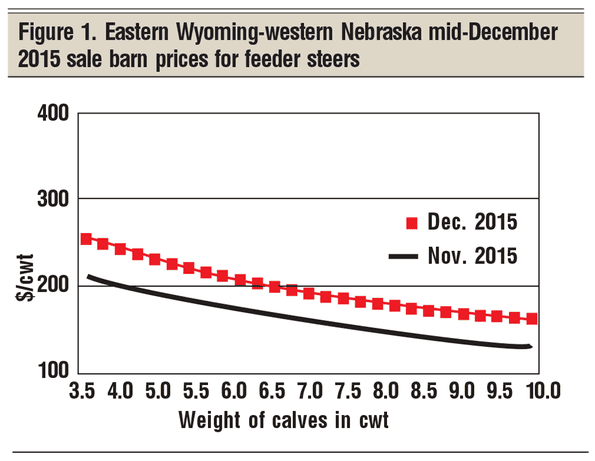Has the cattle market turned?

Finally, there seems to be some light at the end of this dark cattle tunnel. We’re all due; but we all know that the cattle industry is going through some tough, tough adjustments brought on by the high prices of 2014 and early 2015.
When I’m asked what happened in the market hemorrhage of late 2015, I respond with, “Everything turned negative in the cattle business — value of dollar up, exports down, imports up, additional competing meats, threat of retaliatory tariffs, and carcass weights through the roof!” My budgets suggest that finished cattle harvested in mid-December 2015 lost $435 per head if fed with no risk protection. As long as cattle feeders experience those kinds of losses, we will see continued pressure on feeder cattle prices.
Each month I conduct an in-depth price analysis of eastern Wyoming-western Nebraska feeder cattle prices. I then take these current feeder cattle prices and combine them with the most current livestock futures market prices to project feeder cattle and slaughter cattle prices out approximately one year into the future. I also use the corn futures market prices to project corn prices out into the next year.

Each month’s price projections are entered into an extensive set of cattle budgets, which I use to project cattle profits for approximately the next year. This month’s Market Adviser is based on my mid-December 2015 price and budget analysis. In summary, I see some light at the end of this cattle marketing tunnel.
My mid-December 2015 prices analysis, however, was extremely sobering as feeder cattle sale barn prices continued downward from mid-November to mid-December (Figure 1). Five-hundred-fifty-pound steers averaged $181 per cwt — down $42 from mid-October 2015 and down $31 from mid-November 2015.


The feeder cattle futures market is no different. Figure 2 shows the monthly change in feeder cattle futures prices by contract month from mid-November 2015 to mid-December 2015. Every single contract month went down substantially. Figure 3 shows the magnitude of the price drop from mid-November 2015 through mid-December 2015 — it ranged from $6.70 per cwt for January 2016 to $11.27 per cwt for November 2016.
As I look for clues about where the bottom might be, feeder cattle futures suggest a temporary bottom in March 2016, then rise slightly for five months, only to drop again in the last half of 2016. Current indications are that annual 2016 feeder cattle prices will be below the annual 2015 feeder cattle prices by quite a margin (Figure 4).

My expectation is that feeder calf prices will continue downward until cattle feeders can see some profit on finished cattle. I argue that before the market can stop hemorrhaging, we have to remove the backlog of heavy slaughter cattle. The goal in the last quarter of 2015 and the early part of 2016 has to be to remove the remainder of these heavy slaughter cattle. By the time that you read this, I hope we are about rid of the heavy cattle backlog.
My price projection system combines eastern Wyoming-western Nebraska sale barn prices, feeder cattle futures and live cattle futures, and provides a set of suggested planning prices presented in Figure 5.

Figure 5 presents actual 2014 and actual 2015 prices, and summarizes my current 2016 suggested planning prices. These planning prices suggest more downturn into January 2016 and then a kind of leveling off for the rest of 2016. Slaughter cattle prices are projected to struggle into 2016; to hit the 2016 high this spring, likely in April; and then taper off into the fall, hitting a seasonal low in October. I read this table as suggesting feeder prices will trend lower into the first quarter of 2016 and then sort of level off at a new normal. The key words here are “sort of level off” and “new normal.”
The line for 550-pound calves in Figure 5 presents my fall weaning planning price for fall 2016. This projection suggest October 2016 weaning prices of $166 for 550-pound steer calves — a $44 drop from October 2015 weaning prices. Further study of the 500- to 600-pound calf price projection line suggests that most of this drop occurs by the end of the first quarter of 2016.
The red numbers in Figure 5 are the planning price numbers I use in my grass cattle budgets. In 2016, I project 600-pound steers going on grass at $162 per cwt and coming off grass at $137 per cwt, suggesting a favorable buy/sell margin of minus $25. Grass cattle could become attractive again in 2016.
In the meantime, feeder cattle prices are expected to continue adjusting downward until cattle feeders can make money feeding newly placed feeders. The key economic question is, how far do feeder cattle prices need to come down before profit returns to the cattle feeding sector?
My budget for placing 800-pound feeders on feed in mid-December 2015 to be marketed in May 2016 suggests a $93 profit. Given that the market is still trending downward as this is being written, this would require that a mid-December 2015 risk management hedge be used to lock in the mid-December 2015 futures sale price for May 2016 slaughter.
| Download this article in .PDF format |
Interestingly, my budget for placing 550-pound steer calves during December 2015 in a retained ownership program with a target slaughter date of August 2016 also shows that a profit of $46 could be locked in. These types of potential feeding opportunities should at least slow down the hemorrhaging in feeder prices, and should signal a turnaround in feeder prices.
Another budget for placing 875-pound feeder steers valued at $131 per cwt in a custom feedlot in late February 2016 and projected to be harvested in July 2016 at $118 per cwt is projected to generate a $169 profit. If this level of profit materializes, a floor could easily be established in feeder cattle prices.
The mid-December 2015 feeder cattle futures chart suggests a low in March 2016, with a small upward trend from April 2016 through August 2016, and then a downward trend again into weaning. If I average my mid-month feeder cattle prices for each calendar year, I get the values plotted in Figure 4. This analysis suggests that the annual average feeder cattle futures could average $54 lower in 2016 as compared with the 2015 average annual price. But finally, cattle feeders should start making money again! Stay tuned.
You might also like:
Wendy's addresses antibiotic use in beef production
9 new pickups for the ranch in 2016
3 steps for preparing for farm economy downturn
Is production efficiency the answer to falling cattle prices?
What's ahead for the beef industry in 2016? 10 megatrends to watch
15 best winter on the ranch photos
Calving Checklist: Everything you need to know & have before calving
About the Author(s)
You May Also Like






